Nothing's Been Lost
hagstones & herring-charms
Hawthorn by the field gate with blossom buds preparing to open for Beltane, time of greenwood marriages, maypole dancing and other joyous spring celebrations, 14 April 2025
Hello friends, and welcome to this April full moon edition of Bracken & Wrack.
Reading through what I’ve written, I have to say that I can’t really detect an overall theme for this issue, although certainly it’s coloured by the greening of the land. Absolutely not the ‘greening’ of fishing boats, though, as you will see if you read on.
So, this time we have:
‘Like damp linen pegged on the line’: an April walk along the lane
Halesworth Day of Dance
Over For The Lord: folklore of the herring-fishers
Poetry by Hilary Llewellyn-Williams
Singing of Spring: sitting with the spirits at Rowtor Rocks
Sunshine, Windmills & Horse-goddesses: a recipe for Gypsy Spinach
Yesterday, once the much-needed rain had stopped, I walked to the end of the lane and was amazed at how the spring had moved on in the space of only a day or two. Not five minutes ago, or so it seems, the sticky buds on the big horse chestnut trees were just parting to reveal the first damply unfurling leaf clusters. By yesterday they had stretched their fingers, revelling in the spring air. Although they still hung like crumpled linen pegged on a line I could see that they were bracing themselves for the upward whoosh. Looking more closely I could even see blossom pyramids beginning to lift their knobbled heads. By May’s Eve, surely, spring’s pull will draw them to a crescendo before exploding in tiny stars.
Horse chestnut along the lane, 14 April 2025
Walks along the lane, even just to the end and back, always reveal something new and rewarding as the seasons turn. But sometimes it feels good to strike out further afield to see those changes through a different lens. Perhaps you spend time getting to know a completely unfamiliar landscape, or you find your way to an event steeped in folklore and tradition like the Day of Dance in Halesworth in Suffolk that we attended earlier in April. The event wasn’t actually specific to springtide, but somehow those folk tunes and dances with their hypnotic rhythms feel like a celebration of the earth’s stirring, the springing up of seeds and the approach of Beltane’s fiery magic.
The dance teams had wonderful names like Oxblood Molly (who hosted the event in their home town), Boudicca, Sutton Masque (favourites of mine who come from the fenlands close to the village where my grandparents and great grandparents lived), Holt Ridge, Belchamp, Pretty Grim, Golden Star (our most local side), Kemp’s Men, Danegeld, Fiddlesticks and Slack Ma Girdle. A friend, Mike, plays fiddle for Rumburgh so we were able to have a word with him and gain a few insider insights.
Like the annual Whittlesea Straw Bear Festival, the Day began with a procession and a show dance by each team before they split off into groups of three or four sides who moved between outdoor spaces around the town to perform a couple of dances at each one. Traditionally these would always be pub forecourts as watching the dancing with ale in hand was an obligatory part of the ritual. This wasn’t rigorously held to in Halesworth though :-)
It was impossible to resist the urge to take lots of photos and footage, but I’ve somehow managed to pick a single image to give a flavour of the day. I’ve put some of the footage into my most recent YouTube video, which I’ll link below in case you’d like to see more.
Lots more Morris and Molly dancing fun in ‘Dancing the Witch’s Trail’, April 2025
‘OVER FOR THE LORD’: folklore of the herring-fishers
In Winter’s Grave: marsh pilgrims & tattered taffeta I began the story of our long walk to Great Yarmouth along old railway line and river’s edge, over marsh and field, and always with another sentinel windmill as the next landmark to make for.
This time, I’m going to leap ahead right to the end of the trail (with a middle bit next time: that’s Bracken & Wrack logic for you) because I just wanted to get a word in about the church of St Nicholas, Great Yarmouth. We had decided to finish the spring equinox leg of our journey here in honour of the seven named women known to have been convicted of witchcraft, executed and buried in St Nicholas’ churchyard. I’ll write more about the Great Yarmouth witches soon, but I mention the location as - foot-weary from what may have been a 50 mile walk carrying very heavy backpacks - we had decided to have a rest and a wander around the church before getting the bus homewards.
Partly obscured by one of a series of Easter-related contemporary paintings that had been fixed in front of it was a panel that told of some fascinating folklore drawn from local fishing traditions. Great Yarmouth was once world renowned for the almost unimaginable quantities of herring that were fished in these waters before being brought ashore and processed in huge quantities on the quay. In common with other close-knit communities, local customs and practices often echo more widespread beliefs but will often contain a unique slant or variation.
One of these place-specific practices is linked to Good Friday, which is why I wanted to include it this time. They’re all interesting though, not least because the list found a place in a Christian church despite the mention of gods. In fact, my curiosity was piqued by that glimpse and I’ve since discovered several more folkloric curiosities.* Most of these were collected in Lowestoft, not far from Great Yarmouth. The two fishing ports share many similarities, so I feel sure that the same observances would have taken place at both of them.
If you hang up a herring in your kitchen on Good Friday (you have a couple of days to do this) your household will be protected for the year ahead.
The first part of any catch should always be thrown back into the sea to appease the sea gods.
No drowned sailor or other corpse should be pulled back on board a fishing boat, as the old gods need their quota of lives each year.
Eggshells should always be broken after cracking eggs because half an eggshell could provide a witch with a craft in which to put to sea and cause mischief. Similarly, after a boiled egg has been eaten, the shell should either be broken or turned upside-down in the egg-cup and a hole poked through it.
Never launch a vessel on a Friday. This will bring bad luck, perhaps even the total loss of both vessel and crew.
Fishing boat at Cromer, Norfolk
Never wash a fisherman’s clothes on the day he leaves home to start a voyage. This would wash his life away, causing him to drown.
Never watch a loved one depart on a fishing voyage or they will never be seen again.
Allowing a member of the clergy to step on board is bound to bring bad luck.
Dislike of nuns: Lowestoft (and no doubt Yarmouth) fishermen would refuse to put to sea if they saw a nun on their way to the harbour. The only way to ward off the bad luck would be to touch an object made of iron and to shout ‘Cold Iron!’ or ‘Iron, Iron!’
Copper coins inserted into fishing net corks not only act as weights but act as a good luck charm, being an offering to the gods in exchange for a good catch.
A successful herring voyage is assured if you raise a toast to it, sprinkling a few drops of the wine or spirits over the nets.
Buying a catch: throwing pennies overboard before trawling the seas will buy a catch from The Almighty.
Chanting the words ‘Over for the Lord’ before the first net is cast is a charm for a good catch of herrings.
Never leave deck brooms on top of nets, either on board ship or at the quayside. This invites disaster next time the nets are cast, as they will be ‘swept away’.
Fishing boats and gear on Cromer beach, Norfolk
Dislike of pigs: the biblical reference to a herd of swine running into the waters and being drowned causes unease among fishermen. Not only should crew members never mention pigs on board ship, but pork and bacon should not be carried there.
Dislike of other animals: while pigs attract the greatest ill-feeling, many other animals are taboo in on-board conversation. Rabbits, cattle, horses, sheep, monkeys, elephants and camels are a few examples of taboo topics. When radio receivers were first installed on the Lowestoft and Yarmouth fishing fleets during the 1920s and 1930s, some skippers would switch off livestock market reports in case any of the forbidden animals were referred to.
Never whistle on board ship, either at sea or in port. It’s a sure way of raising high winds and gales.
Conversely, if a wind was required, sailors could ‘buy the breeze’ from sea-witches - a cord knotted three times. Untying each knot would get the wind blowing behind the boat once more. The blessing card that came with my Sea Charm candle had a strand of woad-dyed yarn attached to it, complete with three knots. (Sea Charm candle, Midsummer Solstice 2021)
Singing on board ship will lead to poor herring catches.
Unless absolutely necessary, never stir a cup of tea with a knife or a fork while on board. It will cause trouble among crew members. ‘Stir with a knife, stir up strife’, ‘Stir with a fork, stir up talk.’
Never wear green on board ship, nor paint a boat in that colour. It’s very bad luck indeed.
White-handled knives should never be taken on board, whether for eating meals or gutting fish. White is the ‘corpse colour’ and therefore associated with death.
White stones are similarly unlucky and if any are trawled up from the seabed they must be quickly thrown back. A new ship’s ballast must be inspected for white stones and as many of those as possible should be discarded.
Pierced ears and the wearing of earrings improves eyesight. Custom dictates that it’s the left ear that should be pierced, and a single gold ring worn therein.
The membrane found on the head of some newborn babies - the caul - is a sovereign charm against drowning. If you’re lucky enough to procure one - and they fetch a high price - it should be carried with you, preferably in a small bag around the neck. Shaped like a boat’s hull, it will keep you safe at sea. Charles Dickens refers to this custom in the first chapter of David Copperfield, and it’s likely that he heard of the practice during his visit to Great Yarmouth in 1849.
Seagulls are the souls of drowned seafarers.
Hanging a string of hagstones (holed stones) in the cabin or wheelhouse, or above their entrances, will bring good luck and guard against infiltration by witches and evil spirits.
Looking through a hagstone at Walcott, Norfolk
*Most of these practices are recorded in Superstition and the Fisherman by David Butcher, on the Lowestoft Old and Now website.
Up here, in a stone barn
this Easter, a straggle
of children and adults saw
the outlawed story retold
of an old resurrection:
a grain reborn as a child
(as we sat in the straw):
a lost child fostered and found
to be wizard of poets, a star
with the wind’s protection.
Out in the yard, our cars
mud-axled, we dispersed,
turned away from the scene.
Now I visit my alder stream
in a double life, knowing
that nothing’s been lost. A raven
croaks Brân overhead:
banished westwards, but still
surviving. And alder flowers
green as thieves, still growing.
Hilary Llewellyn-Williams, from ‘Alder (March 18 - April 14)’ in the Tree Calendar sequence
Greenwood magic in Hethel Woods, 12 April 2024
SINGING OF SPRING: sitting with the spirits at Rowtor Rocks
A church with a stream gurgling along one side of the graveyard, singing of spring. The comforting murmur of a tiny waterfall brushes the peaceful resting place of an eight-day-old baby girl nestled against the old church wall.
It was a vicar here, just in the shadow of Rowtor Rocks, who turned Druid and spent hundreds, thousands of hours carving and shaping and tapping and pecking the natural outcrop into a creation fitting his vision. Or did the spirits of that place guide his hand?
We squeeze between the rocks, through a sculpted doorway to the dim inner chamber, its domed ceiling rippled like willow. Silently we enter one after the other, finding ourselves drawn into the cave, feeling into the presence of the druid-vicar with his tap tap tap. What did he do with all that dust? How did he know when his creation was finished? Did he sit in there, perhaps cross-legged, meditating for hours on the meaning of life? Or was there always one more improvement needed to fit his scheme, one more set of steps to sculpt or basin to hollow?
We’re becoming well practised. Staffs propped in the only dry corner, crossed towards their horned and spiralled heads. At their feet, the altar circle unfurled with wand, recorder, whorl and heart. Before it I set the incense pot; a pinch cast onto sparking charcoal on the earthen floor. Sweet smoke curls: our blend is good. Immediately the aroma fills the darkness, broken only by the glowing edge of the charcoal. Another circle.
Warmed with us in the earth’s womb, my recorder notes fall hesitantly at first and then strike full and resonant, returning from its walls. We sit with the spirits as the stream and I sing of the spring and of the quickening seed.
Rowtor Rocks, Birchover, Derbyshire, 28 February 2025
SUNSHINE, WINDMILLS & HORSE-GODDESSES: gypsy spinach
Stepping out of the van in the car park, breakfast done and day packs on, we’re all set for a long walk by the Bure and over the marshes. Not that long, actually, in comparison with the one to come a week or two later, but still several miles in the company of seagulls and even a couple of oystercatchers whose beaks flash orange in the March sunshine.
As we gather our things I notice a woman close to the hedge beyond the gravelled parking area. She’s dressed a little exotically, her hair is dark and she’s scanning the wild edges that have escaped the taming hand of authority. She’s wearing plastic gloves and holding a large carrier bag, in which she’s collecting - something - I can’t see exactly what.
My first thought is that she’s litter-picking, and what a thoughtful act that is in a public space in Great Yarmouth. Then, she takes out a phone and speaks into it in a language I don’t understand. Looking up I see two more figures approaching; another woman and a man. They, too, have carrier bags in their hands and begin scanning the car park edge at intervals from each other.
Beyond the scrubby hedge is a tiny stream and the man seems to reach almost into it, perhaps even stepping over onto the other side although I don’t want to look as if I’m staring.
I’m curious, though. It can’t be litter. Some of the pieces would be larger and more visible even from here, and there wouldn’t be this continuous stooping and picking motion.
A beautiful day of sunshine, windmills and marshland horse-goddesses later, and now back at home, I open my trusty Almanac to research seasonal snippets for the next issue of Bracken & Wrack. One of my favourites is the 2021 edition which features a Romani recipe for each month, collected by Romani and Traveller historian Robert Dawson.
Turning to the Romani recipe for March, I do a double-take as I read:
Gypsy Spinach
Nettles are a free, nutritious green perfect at this time of year when still young and tender. Wear rubber gloves and gather just the tips. Heat removes the sting.
Gather the tops of young nettles. Wash thoroughly. Cook with a little butter as one would spinach, until tender. Serve on bread fried in bacon fat.
[As a vegan, I would adapt this by sautéing the nettle tops in olive oil, maybe with a little chopped wild garlic for flavour, and serving on toast or soda bread drizzled with more oil.]
We’re in April now, but as it’s a late spring - at least in Norfolk - the nettle tops are still tender, so what are you waiting for?
Sunrise at the kissing-gate, Filby churchyard, Norfolk, 12 April 2025
Oh, and I promised a Bracken & Wrack recommendation in each issue, and that’s it this time - The Almanac by Lia Leendertz. I see that you can even pre-order the 2026 edition (linked here) if you want to get ahead. I’ve collected every one from 2019 to 2025 and find them a wonderful seasonal resource, despite the information specific to each of the years becoming outdated. Not that many of the recipes are vegan-friendly, it has to be said, but I’ve tweaked some of them to suit, and there’s plenty of other content with themes that change every time and gorgeous illustrations to head up each month.
Anyway, I had lots more stories prepared but they will have to wait for the new moon now as I’ve rambled on far longer than I intended to :-)
In the evening kitchen, the day I had my nose pierced with a green gem to celebrate the spring Greenwood, 17 April 2024
Until next time.
With love, Imogen x

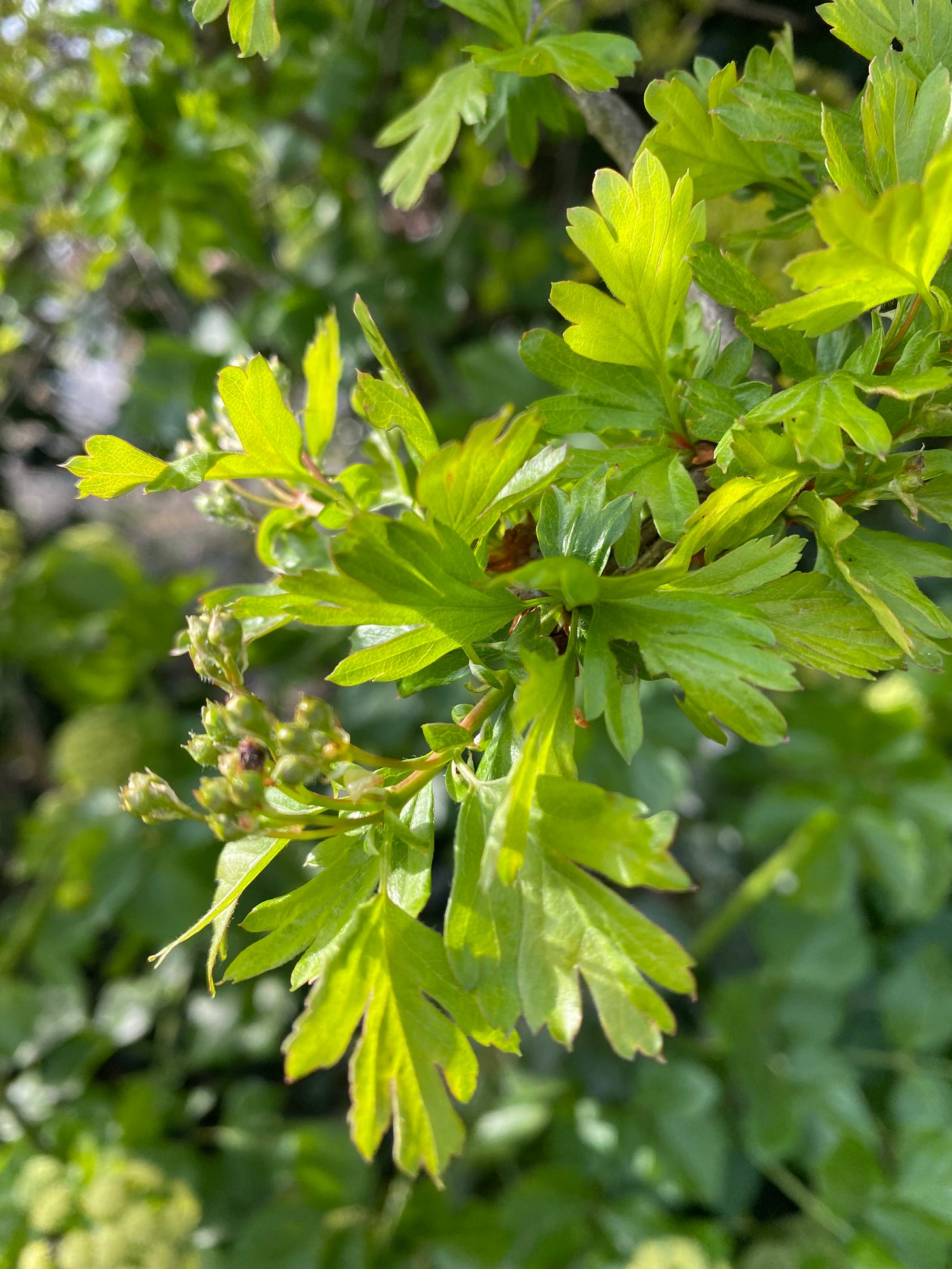

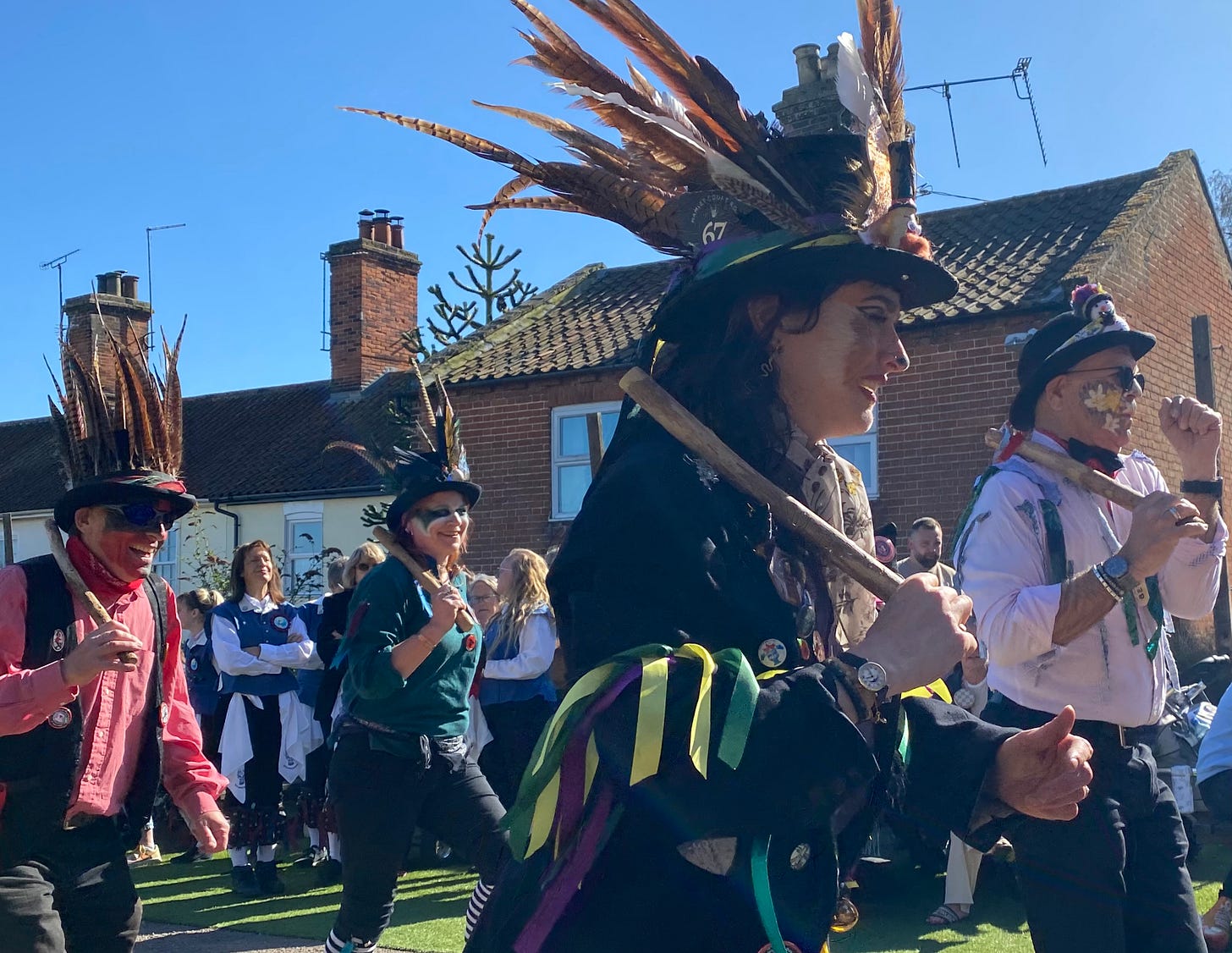
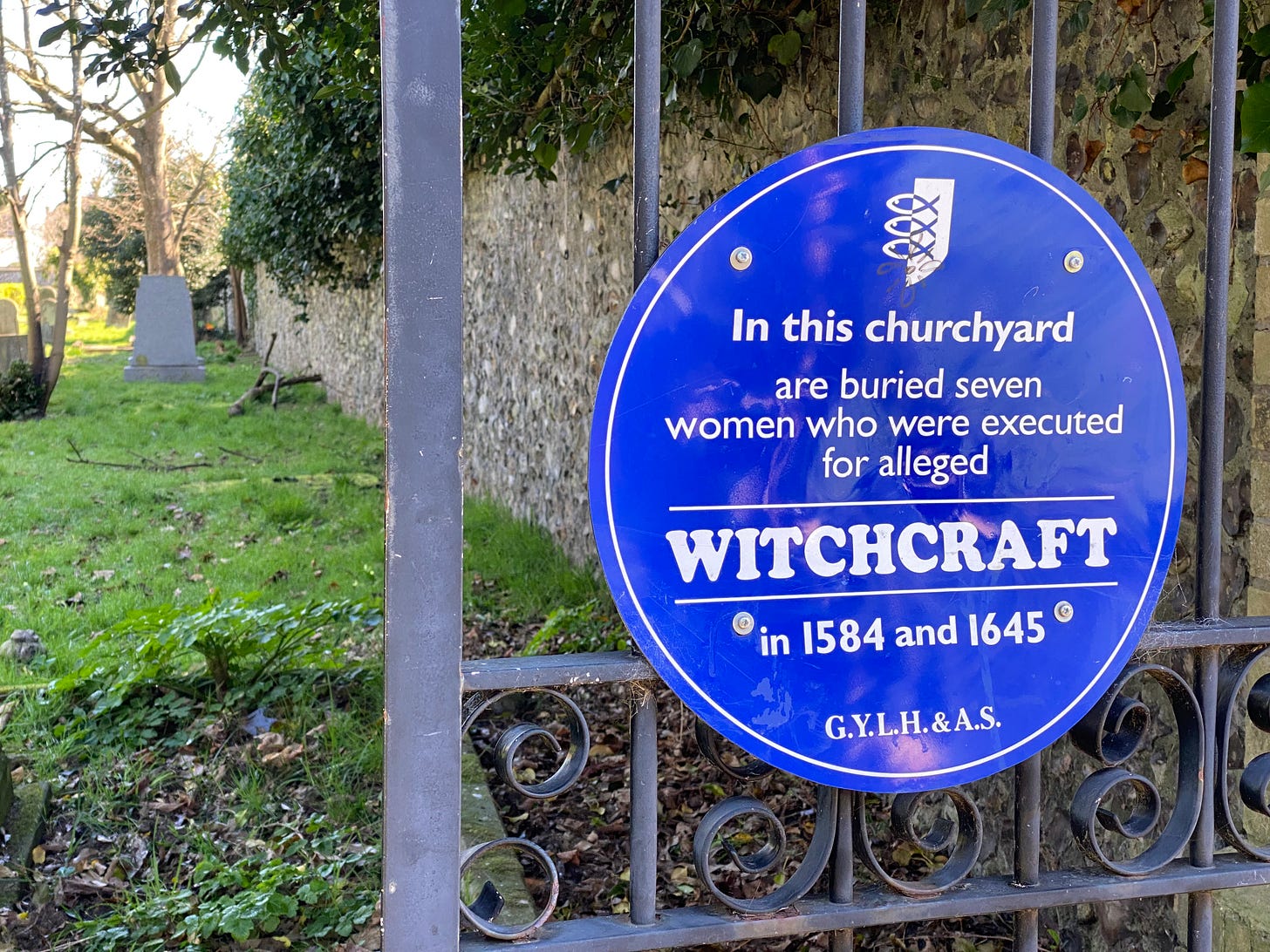
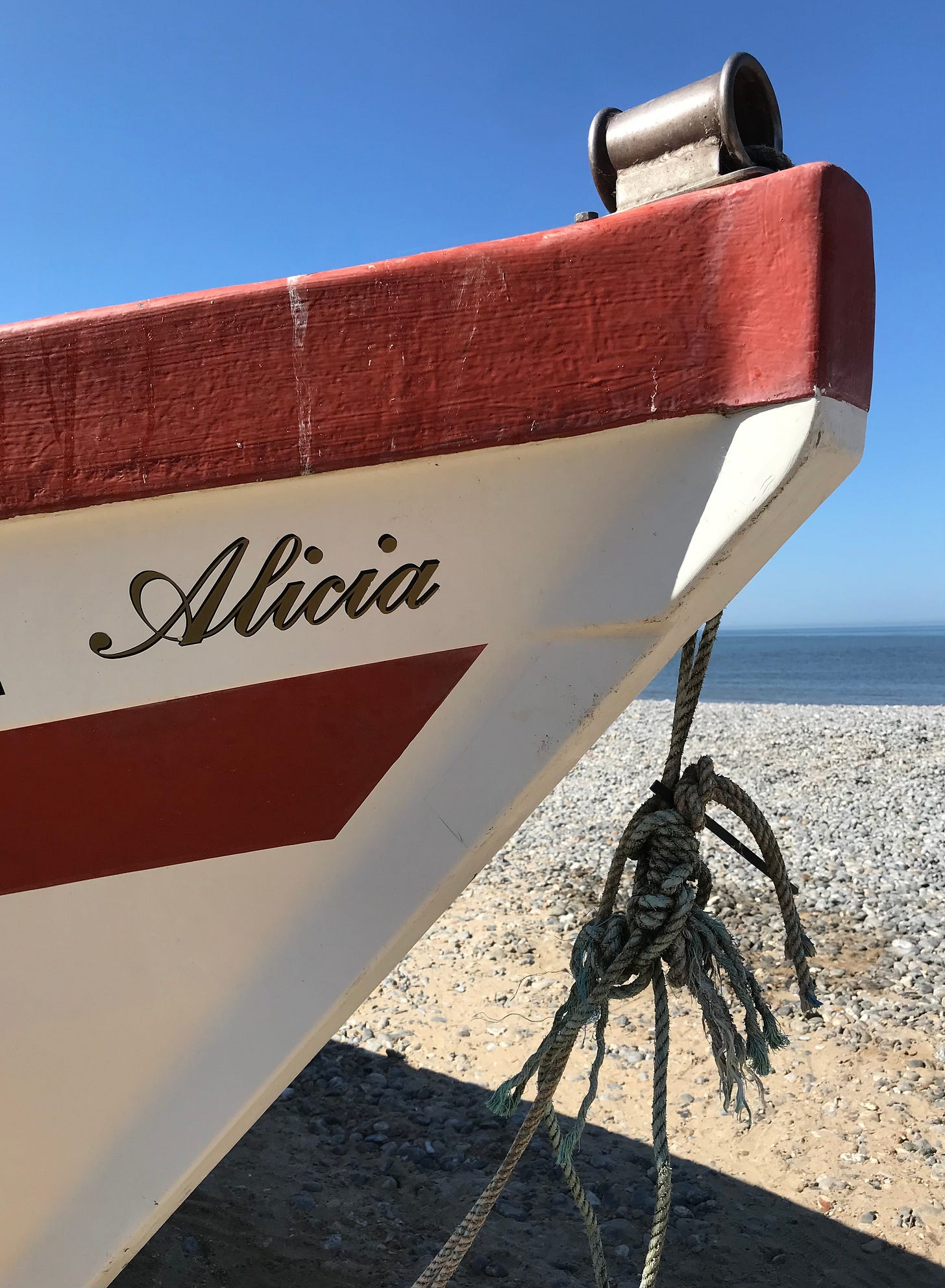
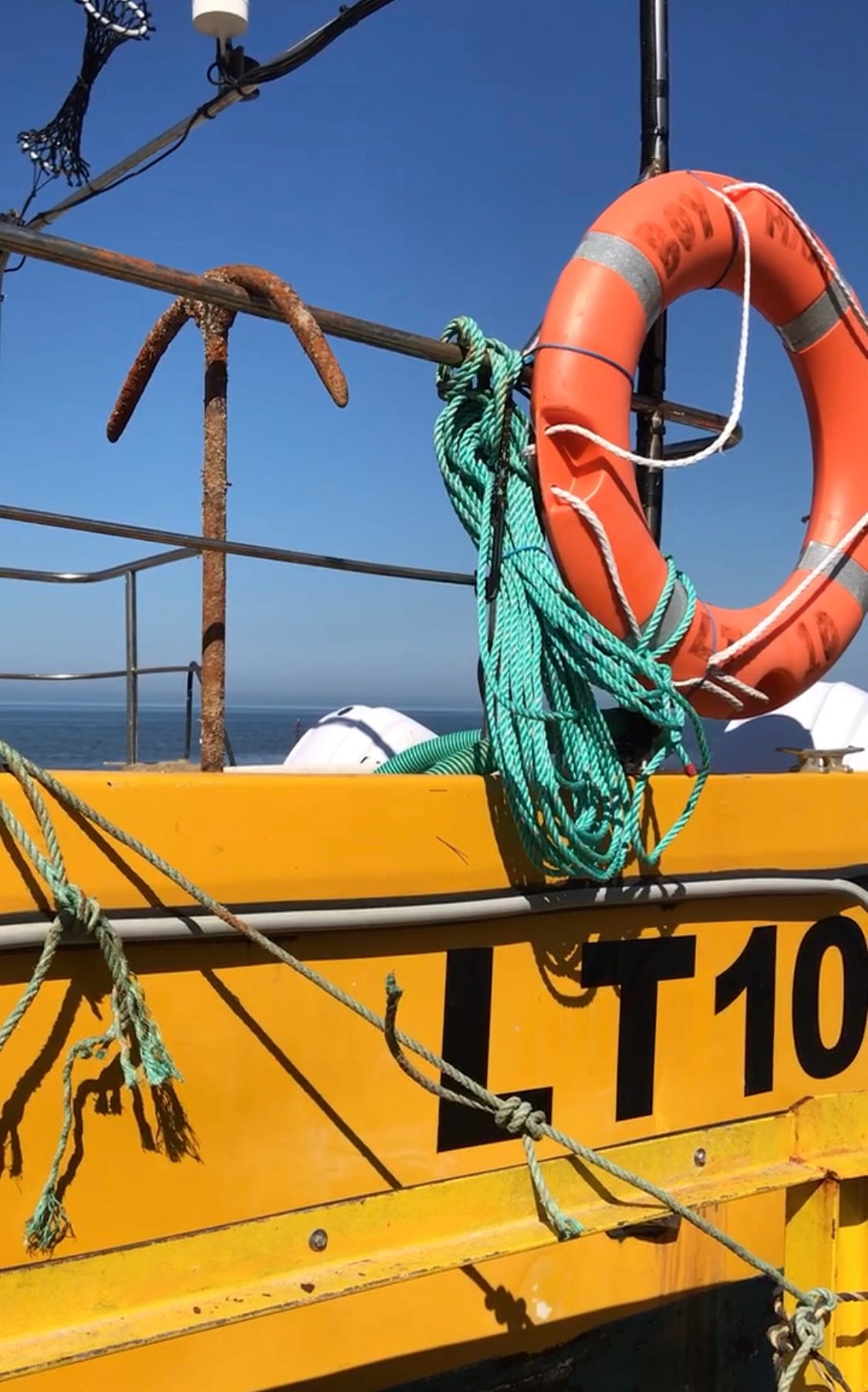
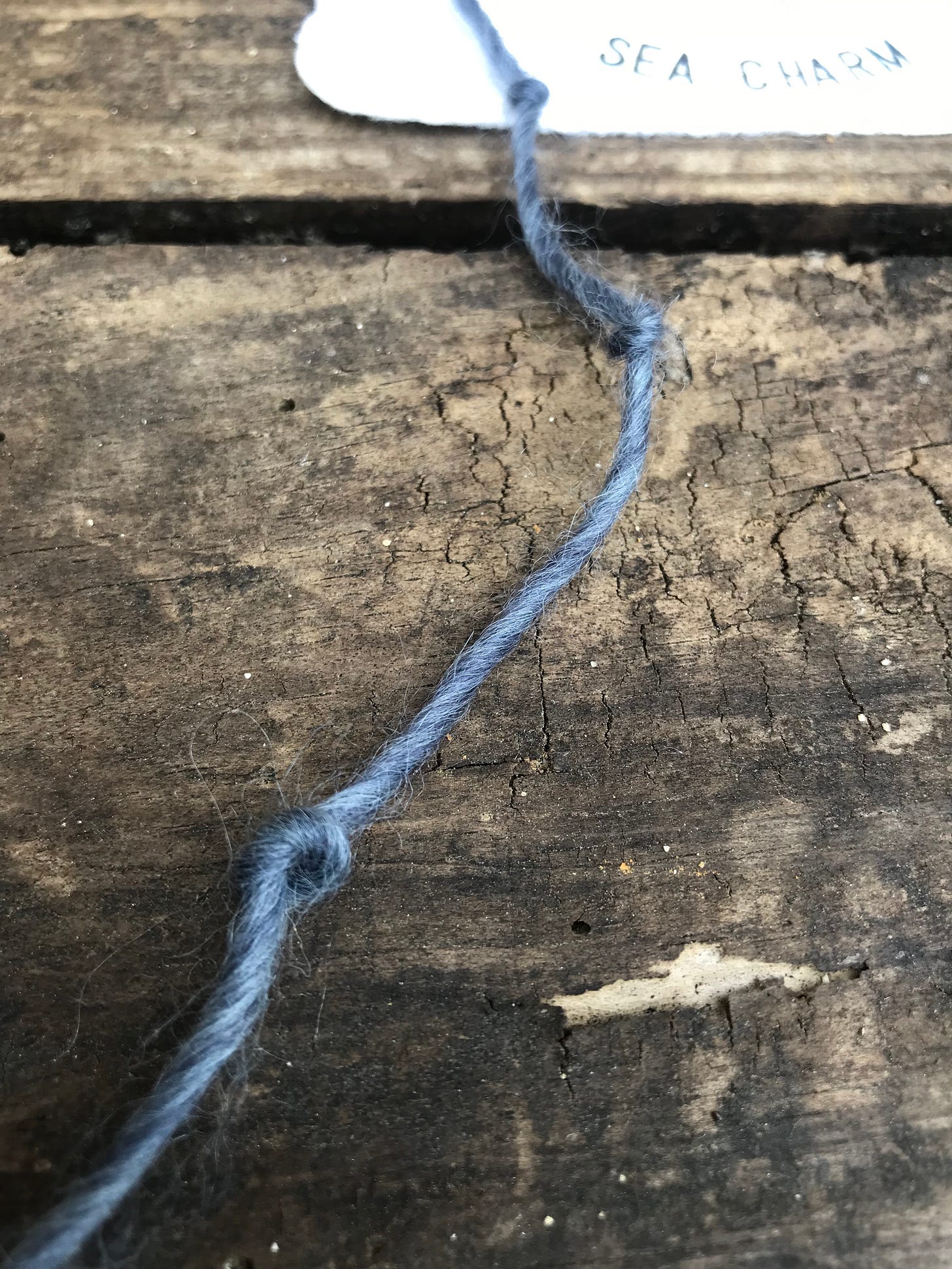
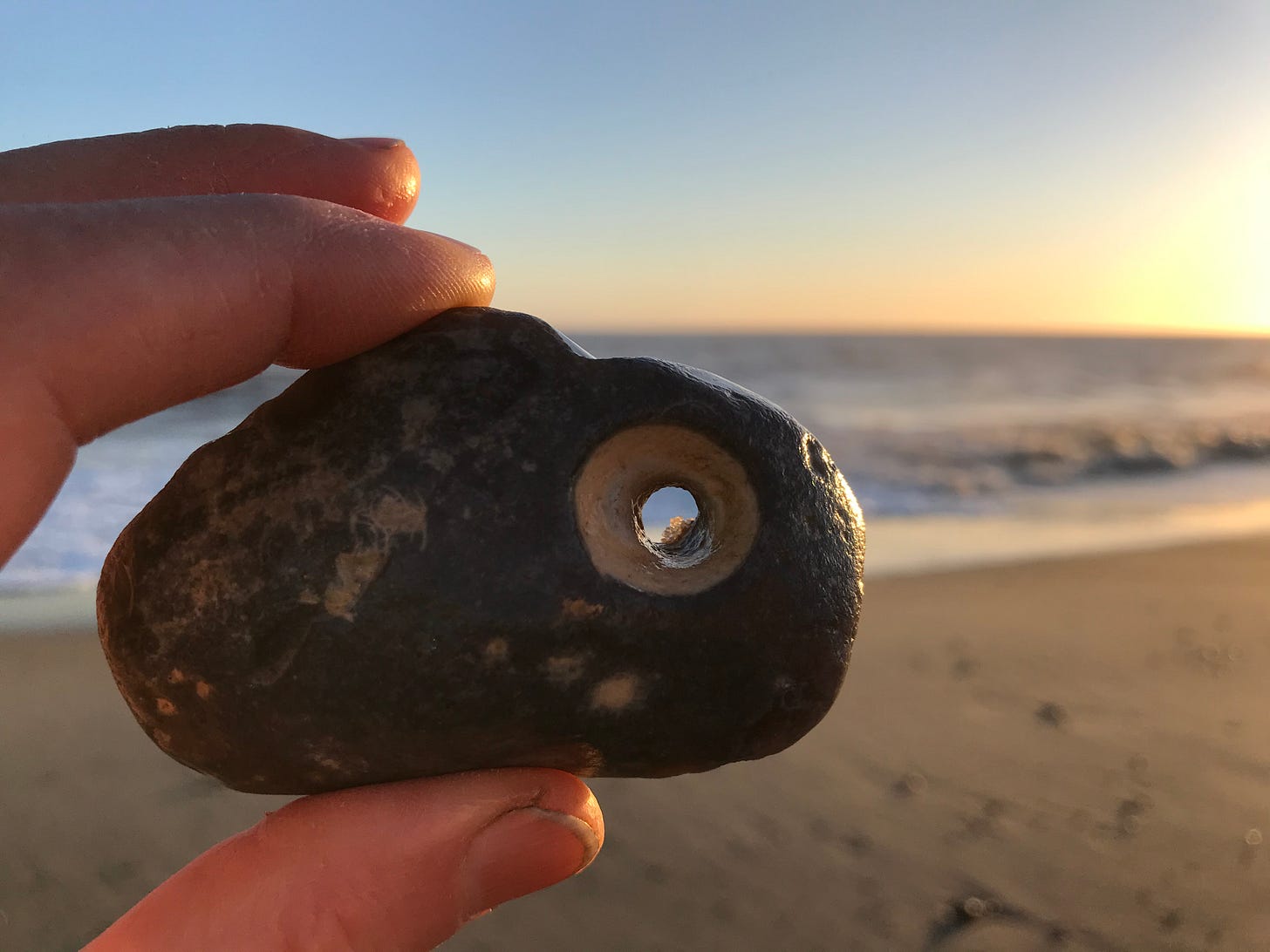
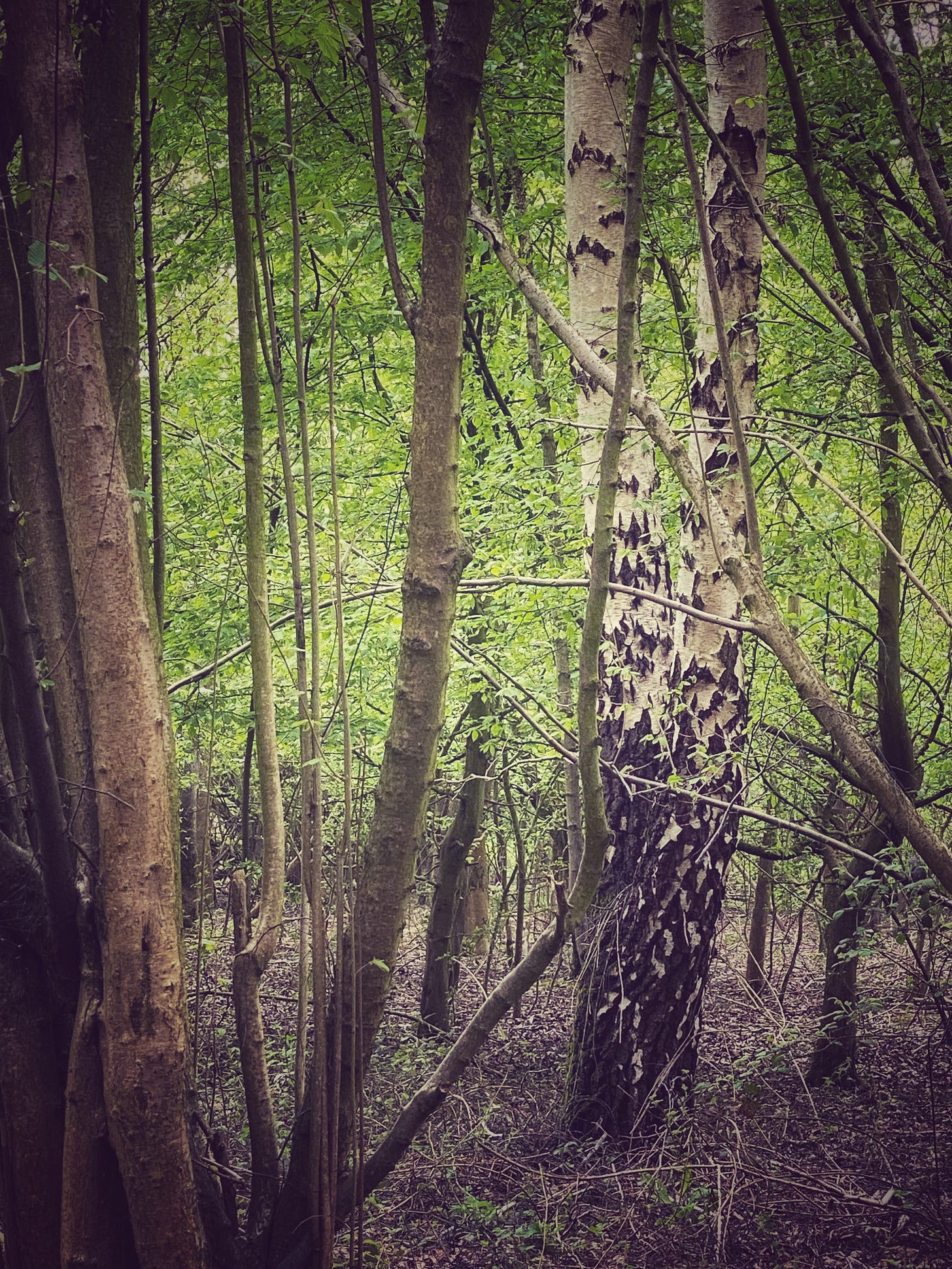
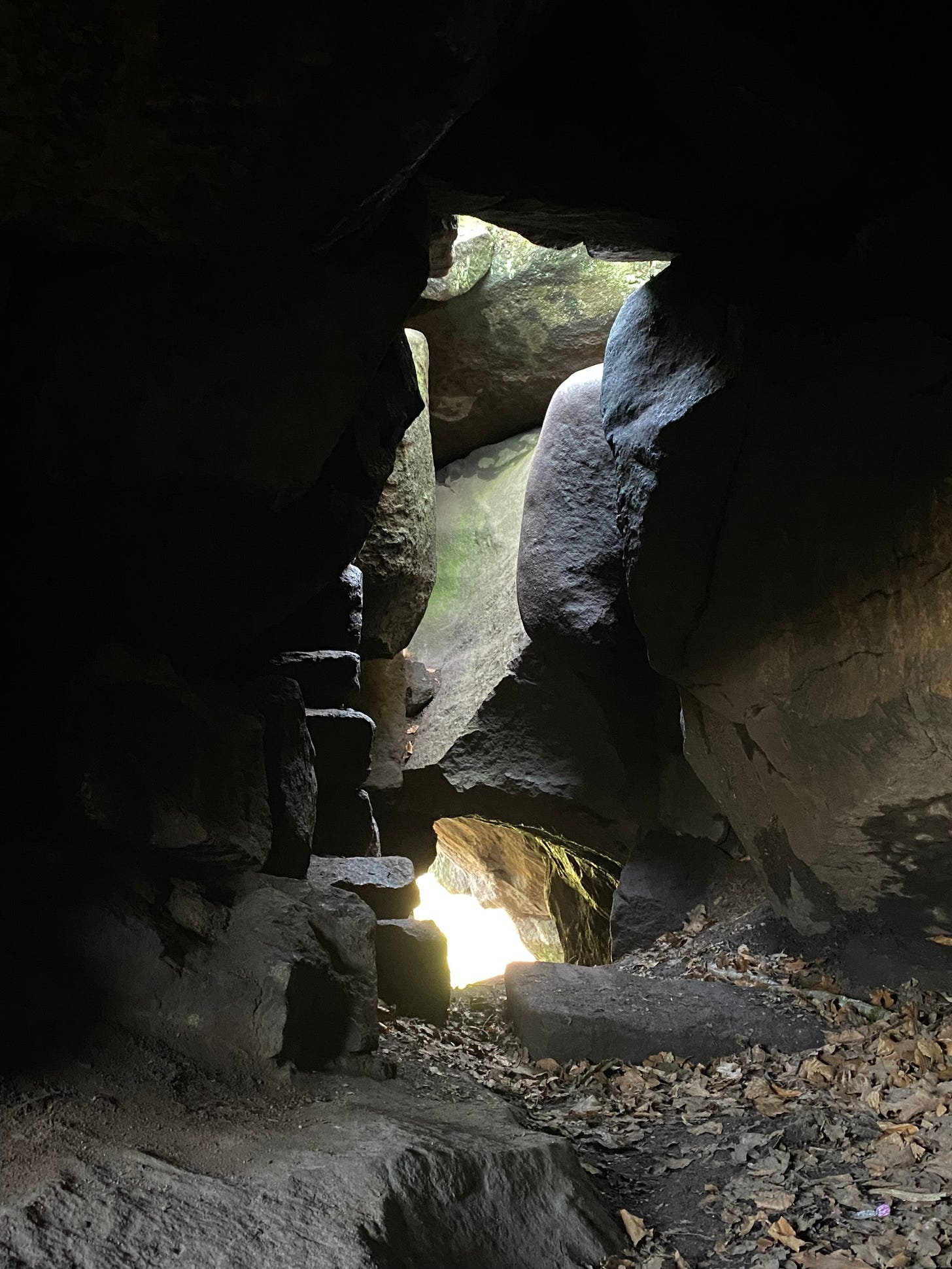


Thank you so much for this!
Imogen you have reminded me that my Gran used to say to poke a hole in the eggshell so a witch couldn't use it. I have not thought of that since I was a little girl!
Lovely writing as always, thank you x